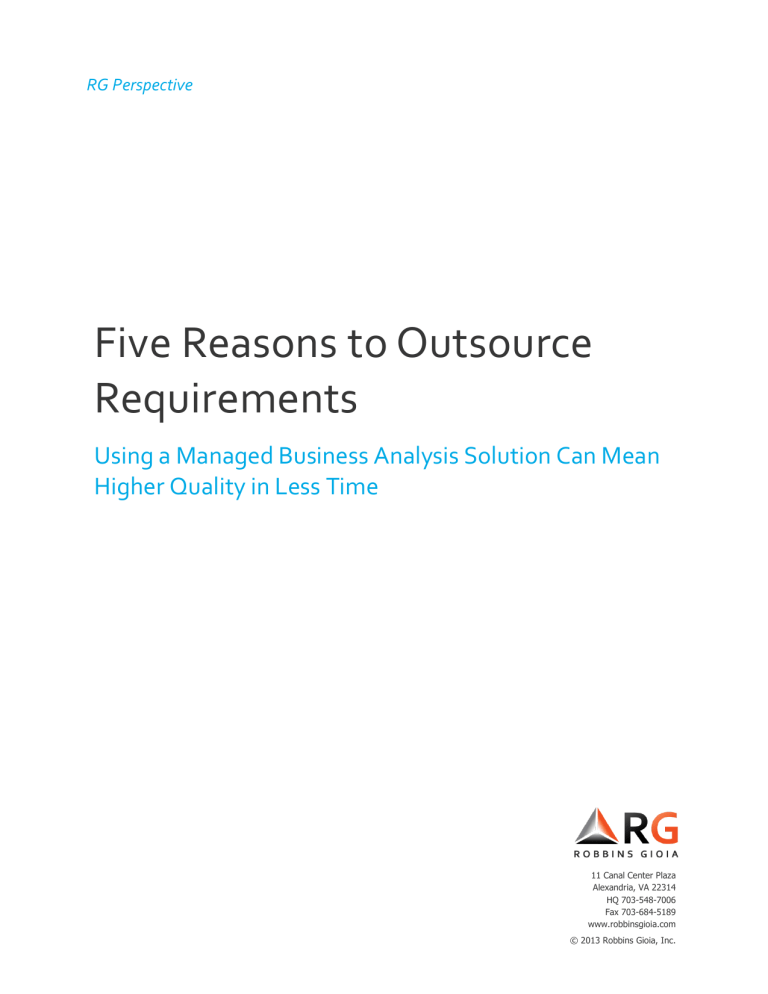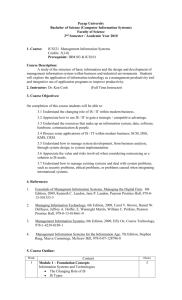Five Reasons to Outsource Requirements

RG Perspective
Five Reasons to Outsource
Requirements
Using a Managed Business Analysis Solution Can Mean
Higher Quality in Less Time
11 Canal Center Plaza
Alexandria, VA 22314
HQ 703-548-7006
Fax 703-684-5189 www.robbinsgioia.com
© 2013 Robbins Gioia, Inc.
Finding, attracting and signing top BA talent into full-time roles is difficult and expensive. Usually projects must be staffed immediately with highly productive business analysts. As a near term solution, the business analysis skills gap can be closed by working with a specialized contractor to provide a managed solution using best-of-breed business analysis talent.
When does it make sense to outsource?
Not every job can be handled internally; in the same way, not all jobs need outside help. How do you determine if it’s worthwhile for you to outsource some or all of your BA functions?
The best strategy is to start by asking three critical questions:
Are you searching for a skill set that is routine for your organization?
If you have many BAs that are up-to-date with the latest techniques and have handled similar projects, then you are likely to be able to find internal resources or hire good candidates for your needs.
Are the upcoming projects somewhat different and/or more high profile than usual?
If the projects you need BAs for are outside the comfort zone of your current staff, you could benefit from outsourcing the BA role to a more experienced organization.
Have you had complaints from either the business or IT side of the house as to the quality of requirements?
In this case, you’ll definitely want to take advantage of using outside expertise so that new projects can be staffed quickly and with a high level of skills – skills that can be transferred to your internal staff as they work as part of the project team.
Five Reasons to Outsource Requirements
If you determine you need outside expertise, finding a managed business-analysis solution can be the best path to obtain world-class’ business analysis expertise to meet immediate staffing needs. The business analyst team from a managed solution will come ready to contribute to project success on day one with:
Vetted, project-tested business analysts
A proven requirements methodology
Industry standard modeling and management tools
Your management may need some evidence that using BA resources from an outside source makes sense. Here’s what we’ve found:
Reason #1: Outsourcing can lower the risks and improve the outcomes of large IT initiatives.
Requirements are much too important not to do right. This is borne out by the dismal results of industry studies and surveys:
31% of all software projects are canceled before completion ($81B wasted)
53% of projects will cost 189% of estimates
Projects that are actually delivered on time and on budget reach only 9% in large companies and 16% in small companies
*Source: Standish Chaos Report
The challenges of software development projects used to be the technology and the availability of skilled people to implement the technology. This was particularly true when software applications were written from scratch. But today this is no longer the case. Software projects today integrate and configure pre-written components from commercial out-of-the-box applications and infrastructure components. Vendors are usually able to work through any issues that come up with interfaces or version incompatibilities. While performance and reliability are always issues,
1
these can usually be overcome by overprovisioning applications with hardware that becomes cheaper each year.
So the problems we face today are not the availability of technology or our ability to implement it. The problems we face today are understanding what we can do with the computing assets we have available. It comes down to business requirements. Do we understand how we can make use of information technology to improve the effectiveness and competitiveness of our business? Implementing technology without understanding fully the business problem your users need to solve is a fast track to disaster.
Skilled business analysts are key to getting good business requirements – and business analysts from outside your organization can bring the perspective, experience and techniques that make gathering those requirements efficient and effective. Most IT organizations overestimate the quality of the requirements they currently get simply because they have nothing to compare.
They have been doing things the same way for so many years that they have difficulty evaluating the effectiveness of their approach.
Reason #2: Outsourcing business analysis can bring new best practices techniques to your organization:
Business processes in most companies and organizations grow increasingly complex year by year due to competitive pressures to add new products and services, to comply with changing regulations, to expand through growth or acquisition, and to support any number of reorganizations. The touch points between information systems and business processes have also increased as more and more manual tasks are taken over or augmented by automation. This makes the job of understanding business operations much more complex. The methods of gathering and documenting requirements that
Five Reasons to Outsource Requirements worked five years ago may not be effective today.
And the skill level required by a business analyst today is much higher than it was even five years ago.
An outsourcing partner that specializes in requirements analysis and business process modeling can bring new best practices techniques into your organization.
Reason #3: Outsourcing can bridge the gap between the IT organization and the business organization.
In most companies the responsibility for requirements analysis and business process modeling is pushed back and forth between the business units and the IT organization. Many companies are creating a program office that reports to the COO or VP of Operations and attempts to bridge the communications gap between business management and IT systems designers. It is not an easy void to fill. Each group has its own culture and mode of approaching issues. An outsourcing partner can help the program office develop systematic methods for business process modeling and requirements analysis that will allow it to more effectively fulfill its mission.
Reason #4: Outsourcing can extend your requirements analysis into business processes and help identify cost effective opportunities for automation.
Many IT-driven requirements projects focus on narrow feature/function issues of a system.
Typically this includes Use Cases or JAD sessions that focus on issues such as the user interface
(screens for query, update and data entry), report layouts, security requirements and other designoriented features of the system. While these requirements are important for technical specification and detailed design, they do not show how the system is supposed to support a
2
business process. IT often presumes that the users know exactly what type of system they need, and the only open question is how the system should look and function.
A model of the overall business process can show how business processes can be re-engineered and where point solutions can have a huge impact on costs and efficiency. The best solutions are not always technical or expensive. An outsourcing partner skilled in business process modeling can help you identify where and how you can get the best return on your investment in business process automation.
Reason #5: Outsourcing can be a cost effective way to get the skills you need when you need them (even when you don’t think you do)
It can take years to develop the skills needed to do rigorous business process models and systems requirements. It is a skill that is developed best through a broad range of projects and system initiatives. An outsourcing partner can bring those skills and experiences to your organization when you need them on a project by project basis or as an ongoing partnership.
A Checklist for Outsourcing
Not all outsourcing vendors are the same, of course. Unfortunately most vendors boast that they have business analysts when what’s really needed is experience in the discipline of business analysis. Here is a checklist that will help you separate the ‘walk’ from the ‘talk’.
Is the consultancy aligned with an accredited business analysis organization
(i.e. IIBA) with accredited analysts that will be “on site” at your organization?
Can the consultancy provide evidence that all consultants are trained on the same
Five Reasons to Outsource Requirements analysis methods which will be used for your organization?
Can the consultancy cite their experience in other industries besides your own where they have helped BA best practices be adopted successfully?
Can the consultancy demonstrate business analysis capability at the strategic, project, and technical levels?
Is the stated goal of the consultancy to enable best practice within your organization so that you can be effective after they depart?
Does the consultancy provide an integrated approach that considers tools and method together?
Can they adapt business analysis techniques to tools used by your organization, or recommend the right tool for your specific needs?
A consulting vendor should meet all of the criteria above in order to help your organization address its competency gap.
3
Are these the Requirements
You Need?
“We make sure that requirements we get from users are J2EE compliant”
IT Vice President
Have You Experienced This?
“We have a very tight and disciplined method for gathering requirements. We know exactly how to do it here.”
SVP Information Technology
“We need help. We need to put in place more formal methods for requirements analysis because we are all pretty new at this and not sure what we are doing.”
Project Director reporting to SVP








